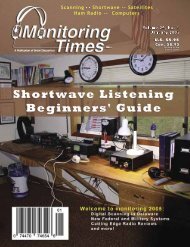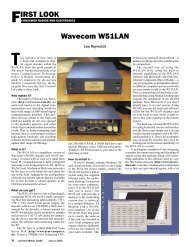RIGHT-click here - Monitoring Times
RIGHT-click here - Monitoring Times
RIGHT-click here - Monitoring Times
Create successful ePaper yourself
Turn your PDF publications into a flip-book with our unique Google optimized e-Paper software.
The Road to New LPFM<br />
It seemed an impossible task: Battling<br />
mega-media companies and the FCC in order<br />
to give communities a voice via Low Power FM<br />
radio stations amid the clamor of dollar-driven,<br />
spectrum-grabbing pros. Who would play David<br />
to the broadcast Goliaths? Since we’re talking<br />
myths and legends, why not Prometheus?<br />
Like the Prometheus of legend, who brought<br />
fire to mortals, today’s Prometheus Radio Project,<br />
as indicated by the organization’s logo, seeks<br />
to bring radio (at least LPFM) to mortals (well,<br />
non-commercial broadcasters, anyway).<br />
Begun in 1998 as a small group of Philadelphia-based,<br />
local-radio activists, Prometheus has<br />
had a huge impact on America’s FM band. Thanks<br />
to their relentless efforts battling commercial<br />
broadcast interests and the FCC, in court and<br />
out of court, this small organization managed to<br />
slip a wedge into the microscopic crack between<br />
big-time broadcast lobbyists and the FCC.<br />
Finding a Frequency<br />
To apply for an LPFM license, you must<br />
specify the frequency and location your station<br />
will use. This is more complicated in urban<br />
areas, w<strong>here</strong> the radio dial is more crowded,<br />
and you will likely need to hire an engineer to<br />
produce an exhibit demonstrating the availability<br />
of your channel. Unfortunately, even an engineer<br />
may not be able to find a frequency in some of<br />
the nation’s most crowded markets, such as New<br />
York City and Los Angeles. However, most rural<br />
areas will have many more open frequencies,<br />
and in some cases you can specify the channel<br />
without paying an engineer.<br />
The availability of any given frequency<br />
cannot be guaranteed until the FCC issues its<br />
final set of rules and procedures for LPFM. Still,<br />
t<strong>here</strong> are a few ways to gauge your chances of<br />
finding a frequency in your area. You can do a<br />
quick check for channel availability in your zip<br />
code at http://prometheusradio.org/zipcodecheck.<br />
For a more thorough search, check the<br />
REC Networks LPFM channel search tool at<br />
http://cdbs.recnet.com/lpfm.php.<br />
The results of this search will designate<br />
your proposed location for an antenna as green<br />
if a channel is easily available, red if a channel<br />
is definitely not available, and yellow if one may<br />
be found with an engineer’s help or a second<br />
adjacency waiver. If the REC Networks search<br />
tool cannot find a frequency for you, you can<br />
also employ a radio engineer to perform a study<br />
to look more closely for any open frequencies,<br />
which you’ll need to do in most cases anyway to<br />
produce the engineering study required in your<br />
application. The cost of one of these surveys<br />
varies from $500 to as much as $3,000 for more<br />
complex studies (often in urban areas) that must<br />
navigate interference or geographic obstacles<br />
with directional antennas.<br />
The rules on finding an available frequency<br />
are among the most important and unresolved<br />
issues the FCC must handle before accepting<br />
new applications. Flexible rules, similar to those<br />
already used by translator stations, could allow<br />
thousands of new LPFM stations nationwide.<br />
That wedge was<br />
the Local Community<br />
Radio Act which had<br />
originally been introduced<br />
as legislation<br />
in 2005 and 2007.<br />
The big break came in<br />
October 2009 when the Act was passed out of<br />
the House Subcommittee on Communications,<br />
Technology and the Internet by a 15-1 margin.<br />
One week later it passed the House Energy and<br />
Commerce Committee by a voice vote. Less<br />
than one month after that it was passed by the<br />
Senate Committee on Commerce, Science and<br />
Transportation. And, by December 16, 2009 it<br />
passed the full House by voice vote. But, it would<br />
take another full year to be passed by the full<br />
Senate. The payoff came when the Act was<br />
signed into law, January 7, 2011. -- Ken Reitz<br />
KS4ZR<br />
The most crucial (and likely most contested)<br />
issue has to do with granting LPFM stations<br />
waivers of the FCC’s minimum distance spacing<br />
on the second adjacent frequency.<br />
These waivers would open up the dial by<br />
permitting LPFMs to use frequencies that are<br />
two <strong>click</strong>s away from other stations on the radio<br />
dial, instead of the current requirement of three.<br />
The Local Community Radio Act authorized<br />
second adjacent frequency waivers in cases<br />
w<strong>here</strong> LPFMs are not predicted to cause interference,<br />
but the FCC must decide how and when<br />
such waivers will be granted, and what sort of<br />
showings applicants will need to make in order<br />
to receive a waiver.<br />
A flexible waiver standard would free up<br />
channels in more crowded markets that might<br />
otherwise have no room for community radio.<br />
In many of the larger markets, second adjacency<br />
waivers could double or triple the number of<br />
open channels, giving local groups a much better<br />
chance to get on the air.<br />
Crafting an Application<br />
Though t<strong>here</strong> is no fee for applying for a<br />
noncommercial license, the FCC will only accept<br />
applications when the LPFM filing window<br />
is open. Since the FCC is currently formulating<br />
new rules (and new applications) for LPFMs,<br />
station hopefuls will have to wait for that process<br />
to conclude and new applications to be released.<br />
However, an Internet search of the term<br />
“FCC Form 318” will produce the instructions<br />
form for the old LPFM application, which may<br />
give you a sense of the process. An important<br />
part of the procedure is the point system by<br />
which the FCC selects among multiple applicants<br />
vying for the same channel, whose applications<br />
are considered “mutually exclusive.”<br />
According to this system of “preference<br />
points,” competing applicants could increase<br />
their chances of being awarded a license on the<br />
basis of three possible points: pledging to broadcast<br />
at least 12 hours every day, committing to<br />
broadcast at least eight hours daily of locally<br />
originated programming, and having established<br />
local presence of at least two years.<br />
As a result, if you are still planning to<br />
incorporate as a non-profit or have just recently<br />
registered, you may want to consider supporting<br />
a more established group to serve as the station’s<br />
licensee. Also, keep in mind that these preference<br />
points may change for new LPFM stations.<br />
The FCC has released proposed rules that<br />
suggest placing additional emphasis on local<br />
presence (perhaps increasing the duration from<br />
two years to four). The proposed rules also suggest<br />
placing additional emphasis on localism, by<br />
adding a second point for stations who pledge<br />
to produce local programming or even making<br />
local programming an eligibility requirement.<br />
Building a Station<br />
Even after you’ve submitted your application<br />
and (hopefully) received an LPFM license,<br />
t<strong>here</strong> isn’t much time to celebrate. Once you’ve<br />
obtained your license, you have a lot of equipment<br />
to buy and only 18 months to get your<br />
station on the air. The cost of this shopping<br />
spree can vary widely, based on w<strong>here</strong> you look<br />
for your equipment. Starting a studio with new,<br />
state-of-the-art technology could easily cost over<br />
$50,000. On the other hand, a studio filled with<br />
consumer grade equipment could be built on a<br />
budget of under $10,000.<br />
People from all walks of life in Rockland, Maine, volunteer at WRFR-LP 93.3 and 99.3 MHz<br />
FM, the only local radio station in Knox County. (Credit: Johanna Lindsay)<br />
August 2012 MONITORING TIMES 17
















